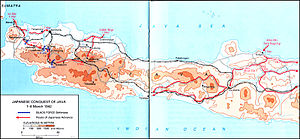Battle of Java (1942)
| Battle of Java | |||||||
|---|---|---|---|---|---|---|---|
| Part of World War II, Pacific War | |||||||
 Map depicting Allied defensive lines (in blue) and the movement of Japanese forces (red) in Java, 1–8 March 1942. |
|||||||
|
|||||||
| Belligerents | |||||||
|
|
|||||||
| Commanders and leaders | |||||||
|
|
|
||||||
| Strength | |||||||
| Netherlands: 25,000; Britain: about 5,500; Australia: about 3,000; U.S.: about 750 Total: about 34,250 troops |
about 34,000 troops | ||||||
| Casualties and losses | |||||||
| Netherlands: ? Britain: ? Australia: 36 dead, 60 wounded; U.S.: US Army 24 KIA; 534 POW US Navy 801 KIA; 369 POW. US Navy casualties: USS Houston and Asheville Of POWS 164 died (Army & Navy). |
Unknown | ||||||
The Battle of Java (Invasion of Java, Operation J) was a battle of the Pacific theatre of World War II. It occurred on the island of Java from 28 February – 12 March 1942. It involved forces from the Empire of Japan, which invaded on 28 February 1942, and Allied personnel. Allied commanders signed a formal surrender at Japanese headquarters at Bandung on 12 March.
ABDA: Koninklijk Nederlands Indisch Leger (KNIL Army): Lieutenant-General Hein Ter Poorten
Imperial Japanese Army:
16th Army: General Hitoshi Imamura
The Japanese forces were split into two groups: the Eastern Force, with its headquarters at Jolo Island in the Sulu Archipelago, included the 48th Division and the 56th Regimental Group. The Western Force, based at Cam Ranh Bay, French Indochina included the 2nd Division and the 3rd mixed regiment (detached from the 38th Division).
The Allied forces were commanded by the Royal Netherlands East Indies Army (KNIL) commander, General Hein ter Poorten. Although the KNIL forces had, on paper, 25,000 (mostly Indonesian) well-armed troops, many were poorly trained. The KNIL forces were deployed in four sub-commands: Batavia (Jakarta) area (two regiments); north central Java (one regiment); south Java (one regiment) and; east Java, one regiment.
The British, Australian and United States units were commanded by British Major General H. D. W. Sitwell. The British forces were predominantly anti-aircraft units: the 77th Heavy AA Regiment, 21st Light AA Regiment and 48th Light AA Regiment. The only British armoured unit on Java was B squadron from the British 3rd Hussars, which was equipped with light tanks . Two British AA regiments without guns, the 6th Heavy AA Regt and the 35th Light AA Regiment were equipped as infantry to defend airfields. The British also had transport and administrative units.
...
Wikipedia
